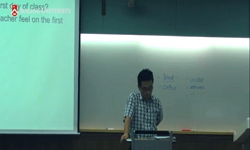Clark and French (1981) proposed viewing the goodbye exchange in English telephone conversation closings as a leave-taking rather than as a termination. Under their framework, the current study as a sequel to Kim (2014b), which explored the kkunhe(yo)...
http://chineseinput.net/에서 pinyin(병음)방식으로 중국어를 변환할 수 있습니다.
변환된 중국어를 복사하여 사용하시면 됩니다.
- 中文 을 입력하시려면 zhongwen을 입력하시고 space를누르시면됩니다.
- 北京 을 입력하시려면 beijing을 입력하시고 space를 누르시면 됩니다.
https://www.riss.kr/link?id=A106050189
- 저자
- 발행기관
- 학술지명
- 권호사항
-
발행연도
2019
-
작성언어
English
- 주제어
-
등재정보
KCI등재
-
자료형태
학술저널
- 발행기관 URL
-
수록면
1-19(19쪽)
- 제공처
- 소장기관
-
0
상세조회 -
0
다운로드
부가정보
다국어 초록 (Multilingual Abstract)
Clark and French (1981) proposed viewing the goodbye exchange in English telephone conversation closings as a leave-taking rather than as a termination. Under their framework, the current study as a sequel to Kim (2014b), which explored the kkunhe(yo) exchange in Korean telephone call closings under the termination view, illustrates that kkunhe(yo) also functions as a leave-taking between the telephone conversationalists who need to reaffirm their ongoing relationships despite a temporary break in their contact. To do so, the study explores its distribution and functions in both interpersonal and transactional corpora of Korean telephone call conversations. The two types of corpora demonstrate a sharp distributional contrast. The kkunhe(yo) exchange emerges only in the interpersonal calls between telephone conversationalists, whose contact stays ongoing. In contrast, never once does it appear in the transactional calls between those, whose contact lasts only through a few calls. The distributional contrast highlights that the exchange serves as a leave-taking between those whose relationship needs a reaffirmation despite a temporary break. Synthesizing the findings of the prequel, the study concludes that kkunhe(yo) operates at two different levels. Interactionally, it serves as a leave-taking, while sequentially functioning as a termination.
목차 (Table of Contents)
- 1. Introduction
- 2. Theoretical Background
- 3. Data and Method
- 4. Distributions of the Kkunhe(yo) Exchange in the Data
- 5. Conclusion and Discussion
- 1. Introduction
- 2. Theoretical Background
- 3. Data and Method
- 4. Distributions of the Kkunhe(yo) Exchange in the Data
- 5. Conclusion and Discussion
- References
동일학술지(권/호) 다른 논문
-
A Feature-Based Analysis of Similes and Metaphorsin Metaphor Theory
- 담화·인지언어학회
- 김해연
- 2019
- KCI등재
-
The Leave-Taking View of Kkunhe(yo) ‘Hang Up’ in Korean Telephone Call Conversations
- 담화·인지언어학회
- 김기태
- 2019
- KCI등재
-
A Feature-Based Analysis of Similes and Metaphors in Metaphor Theory
- 담화·인지언어학회
- Haeyeon KIM
- 2019
- KCI등재
-
- 담화·인지언어학회
- 박혜진(Park, Hyejin)
- 2019
- KCI등재






 DBpia
DBpia



